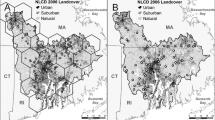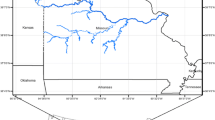Abstract
In the United States, probability-based water quality surveys are typically used to meet the requirements of Section 305(b) of the Clean Water Act. The survey design allows an inference to be generated concerning regional stream condition, but it cannot be used to identify water quality impaired stream segments. Therefore, a rapid and cost-efficient method is needed to locate potentially impaired stream segments throughout large areas. We fit a set of geostatistical models to 312 samples of dissolved organic carbon (DOC) collected in 1996 for the Maryland Biological Stream Survey using coarse-scale watershed characteristics. The models were developed using two distance measures, straight-line distance (SLD) and weighted asymmetric hydrologic distance (WAHD). We used the Corrected Spatial Akaike Information Criterion and the mean square prediction error to compare models. The SLD models predicted more variability in DOC than models based on WAHD for every autocovariance model except the spherical model. The SLD model based on the Mariah autocovariance model showed the best fit (r2 = 0.72). DOC demonstrated a positive relationship with the watershed attributes percent water, percent wetlands, and mean minimum temperature, but was negatively correlated to percent felsic rock type. We used universal kriging to generate predictions and prediction variances for 3083 stream segments throughout Maryland. The model predicted that 90.2% of stream kilometers had DOC values less than 5 mg/l, 6.7% were between 5 and 8 mg/l, and 3.1% of streams produced values greater than 8 mg/l. The geostatistical model generated more accurate DOC predictions than previous models, but did not fit the data equally well throughout the state. Consequently, it may be necessary to develop more than one geostatistical model to predict stream DOC throughout Maryland. Our methodology is an improvement over previous methods because additional field sampling is not necessary, inferences about regional stream condition can be made, and it can be used to locate potentially impaired stream segments. Further, the model results can be displayed visually, which allows results to be presented to a wide variety of audiences easily.
Similar content being viewed by others
References
American Geological Institute: 1987, Glossary of Geology 3rd Edition, Thomson-Shore, Inc., Alexandria, VA, USA.
Amrhein, C. and Suarez, D. L.: 1988, ‘The Use of a Surface Complexation Model to Describe the Kinetics of Ligand-Promoted Dissolution of Anorthite’, Geochimica et Cosmochimica Acta 52, 2785–2793.
Bailey, T. C. and Gatrell, A. C.: 1995, Interactive spatial data analysis, Pearson Education Limited, Essex, England.
Bennett, P. C.: 1991, ‘Quartz Dissolution in Organic-Rich Aqueous Systems’, Geochimica et Cosmochimica Acta, 55, 1781–1797.
Boward, D., Kayzak, P., Stranko, S., Hurd, M. and Prochaska, A.: 1999, ‘From the Mountains to the Sea: The State of Maryland’s Freshwater Streams’, EPA/903/R-99/023, Maryland Department of Natural Resources, Monitoring and Non-tidal Assessment Division, Annapolis, MD, USA.
Byrd, R. H., Lu, P., Nocedal, J. l., Zhu, C., and Siam, J.: 1995, ‘A limited memory algorithm for bound constrained optimization’, Scientific Computing 16, 1190–1208.
Canham, C. D., Pace, M. L., Papaik, M. J., Primack, A. G. B., Roy, K. M., Maranger, R. J., Curran, R. P. and Spada, D. M.: 2004, ‘A Spatially Explicit Watershed-Scale Analysis of Dissolved Organic Carbon in Adirondack Lakes’, Ecological Applications, 14, 839–854.
Copeland, C.: 2002, ‘Water Quality: Implementing the Clean Water Act’, IB89102, Congressional Research Service, Resources, Science, and Industry Division.
Creed, I. F., Sanford, S. E., Beall, F. D., Molot L. A. and Dillon P. J.: 2003, ‘Cryptic Wetlands: Integrating Hidden Wetlands in Regression Models of the Export of Dissolved Organic Carbon From Forested Landscapes’, Hydrological Processes, 17, 3629–3648.
Cressie, N.: 1993, Statistics for Spatial Data Revised Edition, John Wiley and Sons, New York, NY, USA.
Currie, W. S. and Aber, J. D.: 1997, ‘Model Leaching As A Decomposition Process in Humid Montane Forests’, Ecology 78, 1844–1860.
Driscoll, C. T., Blette, V., Yan, C., Schofield, C. L., Munson, R. and Holsapple, J.: 1995, ‘The Role of Dissolved Organic Carbon in the Chemistry and Bioavailability of Mercury in Remote Adirondack Lakes’, Water, Air, and Soil Pollution, 80, 499–508.
Earth System Science Center (ESSC): 1998, Soil Information for Environmental Modeling and Ecosystem Management, ESSC, Pennsylvania State University, Web page, Accessed November 5, 2004, http://www.essc.psu.edu/soil_info/index.cgi?soil_data&index.html.
Eckhardt, B. W. and Moore, T. R.: 1990, ‘Controls on Dissolved Organic Carbon Concentrations in Streams, Southern Quebec’, Canadian Journal of Fisheries and Aquatic Sciences, 47, 1537–1544.
Environmental Systems Research Institute (ESRI): 2002, ArcGIS version 8.3, Redlands, CA.
Furnival, G. and Wilson, R.: 1974, ‘Regression by Leaps and Bounds’, Technometrics, 16, 499–511.
Gardner, B. and Sullivan, P. J.: 2003, ‘Spatial and temporal stream temperature prediction: Modeling nonstationary temporal covariance structures’, Water Resources Research, 40, Art. No. W01102.
Gergel, S. E., Turner, M. G. and Kratz, T. K.: 1999, ‘Dissolved Organic Carbon As an Indicator of the Scale of Watershed Influence on Lakes and Rivers’, Ecological Applications, 9, 1377–1390.
Haneberg, W. C.: 2005, ‘The Ins and Outs of Airborne Lidar: An Introduction for Practicing Engineering Geologists’, Association of Engineering Geologists News 48, 16–19.
Hejzlar, J., Dubrovsky, M., Buchtele, J., and Ruzicka, M.: 2003, ‘The Apparent and Potential Effects of Climate Change on the Inferred Concentration of Dissolved Organic Matter in a Temperate Stream (the Malse River, South Bohemia)’, The Science of the Total Environment, 310, 143–152.
Helsel, D. R. and Hirsch, R. M.: 1992, Statistical Methods in Water Resources, Elsevier Science Publishing Co., New York, NY, USA.
Herlihy, A. T., Stoddard, J. L. and Johnson, C. B.: 1998, ‘The Relationship Between Stream Chemistry and Watershed Land Cover Data in the Mid-Atlantic Region, U.S.’, Water, Air, and Soil Pollution 105, 377–386.
Herlihy, A. T., Larsen, D. P., Paulsen, S. G., Urquhart, N. S. and Rosenbaum, B. J.: 2000, ‘Designing a Spatially Balanced, Randomized Site Selection Process for Regional Stream Surveys: The EMAP Mid-Atlantic Pilot Study’, Environmental Monitoring and Assessment, 63, 95–113.
Hoeting, J. A., Davis, R. A., Merton, A. A. and Thompson, S. E.: 2006, ‘Model Selection for Geostatistical Models’, Ecological Applications, 16, to appear.
Houle, D., Carignan, R., Lachance, M. and Dupont, J.: 1995, ‘Dissolved Organic Carbon and Sulfur in Southwestern Quebec Lakes: Relationships With Catchment and Lake Properties’, Limnology and Oceanography, 40, 710–717.
Ihaka, R. and Gentleman, R.: 1996, ‘R: a Language for Data Analysis and Graphics’, Journal of the Computational and Graphical Statistics, 5, 299–314.
Kellum, B.: 2003, ‘Analysis and Modeling of Acid Neutralizing Capacity in the Mid-Atlantic Highlands Area’, MS Thesis, Colorado State University, Fort Collins, CO, USA, 69 p.
Kiffney, P. M., Clements, W. H. and Cady, T. A.: 1997, ‘Influence of Ultraviolet Radiation on the Colonization Dynamics of a Rocky Mountain Stream Benthic Community’, Journal of the North American Benthological Society, 16, 520–530.
Kortelainen, P.: 1993, ‘Content of Total Organic Carbon in Finnish Lakes and Its Relationship to Catchment Characteristics’, Canadian Journal of Fisheries and Aquatic Sciences, 50, 1477–1483.
Maryland Department of Natural Resources: 1999, State of the Streams: 1995–1997 Maryland Biological Stream Survey Results, Maryland Department of Natural Resources, Annapolis, MD, USA.
Mercurio, G., Chaillou, J. C. and Roth, N. E.: 1999, Guide to Using 1995–1997 Maryland Biological Stream Survey Data, Maryland Department of Natural Resources, Annapolis, MD, USA.
Mulholland, P. J.: 2003, ‘Large-Scale Patterns in Dissolved Organic Carbon Concentration, Flux, and Sources’, in: S.E.G. Findlay, and R. L. Sinsabough (eds.), Aquatic Ecosystems: Interactivity of Dissolved Organic Matter, Academic Press, San Diego, CA, USA, pp. 139–157.
Multi-Resolution Land Characteristics Consortium (MRLC): 2003, ‘U.S. Federal Region III land cover data set’, Web page, Accessed June 17, 2005, http://www.epa.gov/mrlc/.
Neff, J. C. and Asner, G. P.: 2001, ‘Dissolved Organic Carbon in Terrestrial Ecosystems: Synthesis and a Model’, Ecosystems, 4, 29–48.
Olea, R. A.: 1991, Geostatistical Glossary and Multilingual Dictionary, Oxford University Press, New York, NY, USA.
Olsen, A. R. and Ivanovich, M.: 1993, EMAP Monitoring Strategy and Sampling Design, Office of Research and Development, Environmental Research Laboratory Corvallis (OR): U.S. Environmental Protection Agency, Corvallis, OR, USA. Video.
Omernik, J. M.: 1987, ‘Ecoregions of the Conterminous United States’, Annals of the Association of American Geographers, 77, 118–125.
Ouyang, Y.: 2003, ‘Simulating Dynamic Load of Naturally Occurring TOC From Watershed into a River’, Water Research, 37, 823–832.
Peterson, E. E.: 2005, ‘Predicting the likelihood of water quality impaired stream segments using landscape-scale data and a hierarchical methodology’, PhD Dissertation, Colorado State University, Fort Collins, CO, USA, 293 p.
Peterson, E. E., Merton, A. A., Theobald, D. M. and Urquhart, N. S.: in press, ‘Patterns of spatial autocorrelation in stream water chemistry’, Environmental Monitoring and Assessment.
Prusha, B. A. and Clements, W. H.: 2004, ‘Landscape Attributes, Dissolved Organic C, and Metal Bioaccumulation in Aquatic Macroinvertebrates (Arkansas River Basin, Colorado)’, Journal of the North American Benthological Society, 23, 327–339.
Qualls, R. G. and Haines, B. L.: 1992, ‘Biodegradability of Dissolved Organic Matter in Forest Throughfall, Soil Solution, and Stream Water’, Soil Science Society of American Journal, 56, 578–586.
Rasmussen, J. B., Godbout, L. and Schallenberg, M.: 1989, ‘The Humic Content of Lake Water and Its Relationship to Watershed and Lake Morphometry’, Limnology and Oceanography, 34, 1336–1343.
Spatial Climate Analysis Service (SCAS): 1996, Parameter-elevation Regressions on Independent Slopes Model (PRISM), SCAS, Oregon State University, Web page, Accessed October 23, 2004, http://www.ocs.orst.edu/prism/
Strahler, A. N.: 1957, ‘Quantitative Analysis of Watershed Geomorphology’, Transaction of the American Geophysical Union, 21, 913–920.
Sullivan, T. J., Driscoll, C. T., Gherini, S. A., Munson, R. K., Cooks, R. B., Charles, D. F. and Yatsko, C. P.: 1989, ‘Influence of Aqueous Aluminum and Organic Acids on Measurement of Acid Neutralizing Capactiy in Surface Waters’, Nature, 338, 408–410.
Theobald, D. M., Norman, J., Peterson, E. and Ferraz, S.: 2005, ‘Functional Linkage of Watersheds and Streams (FLoWs): Network-Based ArcGIS Tools to Analyze Freshwater Ecosystems’, in: Proceedings of the ESRI User Conference 2005, July 25–29, 2005, San Diego, CA, USA.
U.S. Environmental Protection Agency (USEPA): 1987, ‘Determination of Dissolved Organic Carbon and Dissolved Inorganic Carbon’, in: Handbook of Methods for Acid Deposition Studies: Laboratory Analysis for Surface Water Chemistry, EPA 600/4-87/026, U.S. Environmental Protection Agency, Washington, DC, USA.
U.S. Environmental Protection Agency (USEPA): 2001, Survey Designs for Sampling Surface Water Condition in the West, EPA A620/R-01/004c, U.S. Environmental Protection Agency, Office of Research and Development, Washington, DC.
U.S. Environmental Protection Agency (USEPA): 2005, Level III Ecoregions, Web page, Accessed August 13, 2003, http://www.epa.gov/wed/pages/ecoregions/level_iii.htm.
U.S. Geological Survey (USGS): 2003, National Elevation Dataset, Web page, Accessed January 4, 2005, Available at http://ned.usgs.gov/.
U.S. Geological Survey (USGS): 2004, National Hydrography Dataset, Web page, Accessed January 27, 2005, Available at http://nhd.usgs.gov/.
U.S. Geological Survey (USGS): 2005, Land Use Land Cover (LULC), Web page, Accessed May 25, 2005, Available at http://edc.usgs.gov/products/landcover/lulc.html
Ver Hoef, J. M., Peterson, E. E. and Theobald, D. M.: 2007, ‘Some New Spatial Statistical Models for Stream Networks’, Environmental and Ecological Statistics, to appear.
Vogelmann, J. E., Howard, S. M., Yang, L., Larson, C. R., Wylie, B. K. and Van Driel, N.: 2001, ‘Completion of the 1990’s National Land Cover Data Set for the Conterminous United States From Landsat Thematic Mapper Data and Ancillary Data Sources’, Photogrammetric Engineering and Remote Sensing, 67, 650–652.
Wetzel, R. G.: 1992, ‘Gradient-Dominated Ecosystems: Sources and Regulatory Functions of Dissolved Organic Matter in Freshwater Ecosystems’, Hydrobiologia, 229, 181–198.
Williamson, C. E., Stemberger, R. S., Morris, D. P., Frost, T. M. and Paulsen, S. G.: 1996, ‘Ultraviolet Radiation in North American Lakes: Attenuation Estiamtes From DOC Measurements and Implications for Plankton Communities’, Limnology and Oceanography, 41, 1024–1034.
Yuan, L. L.: 2004, ‘Using Spatial Interpolation to Estimate Stressor Levels in Unsampled Streams’, Environmental Monitoring and Assessment, 94, 23–38.
Author information
Authors and Affiliations
Corresponding author
Rights and permissions
About this article
Cite this article
Peterson, E.E., Urquhart, N.S. Predicting Water Quality Impaired Stream Segments using Landscape-Scale Data and a Regional Geostatistical Model: A Case Study in Maryland. Environ Monit Assess 121, 615–638 (2006). https://doi.org/10.1007/s10661-005-9163-8
Received:
Accepted:
Published:
Issue Date:
DOI: https://doi.org/10.1007/s10661-005-9163-8




